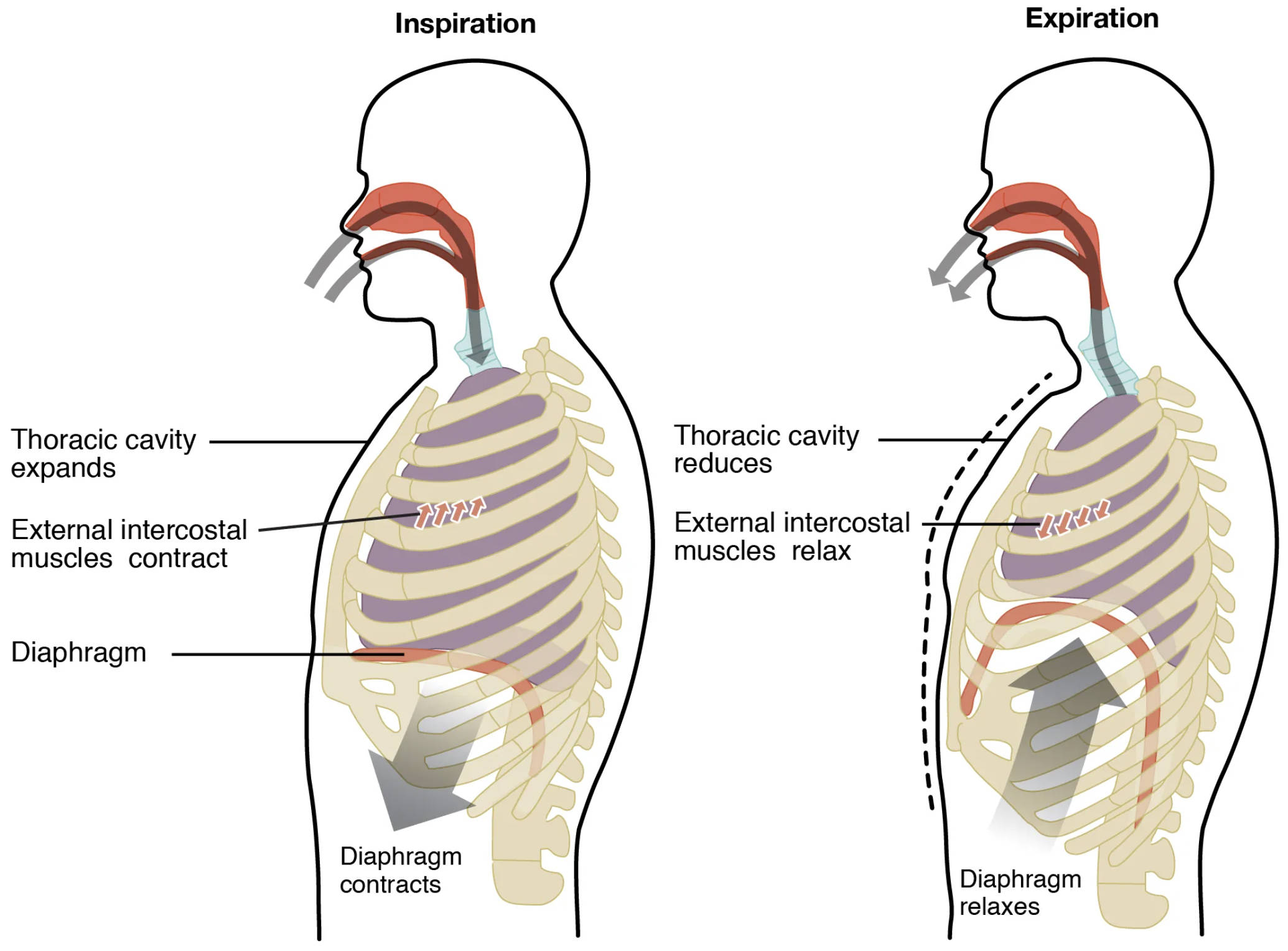Explore the fundamental process of respiration as we delve into the mechanics of normal inspiration and expiration, crucial for life-sustaining oxygen exchange. This article provides a clear, concise overview of how your body facilitates breathing through the coordinated action of muscles and changes in thoracic cavity volume.

Thoracic cavity expands: During inspiration, the thoracic cavity significantly increases in volume. This expansion is primarily driven by the downward movement of the diaphragm and the outward and upward movement of the rib cage.
External intercostal muscles contract: These muscles are located between the ribs and play a vital role in inspiration. When they contract, they pull the ribs upward and outward, further expanding the thoracic cavity.
Diaphragm: The diaphragm is a large, dome-shaped muscle located at the base of the chest cavity, separating the thorax from the abdomen. It is the primary muscle of respiration, contracting and flattening during inspiration to increase thoracic volume.
Diaphragm contracts: During inspiration, the diaphragm flattens and moves downwards. This action creates a negative pressure within the thoracic cavity, drawing air into the lungs.
Thoracic cavity reduces: During expiration, the volume of the thoracic cavity decreases. This reduction is largely a passive process during quiet breathing, as the muscles of inspiration relax.
External intercostal muscles relax: Following their contraction during inspiration, the external intercostal muscles relax. This relaxation allows the rib cage to move inward and downward, contributing to the reduction in thoracic volume.
Diaphragm relaxes: After contracting, the diaphragm relaxes and returns to its dome shape. This upward movement pushes air out of the lungs, completing the expiratory phase.
The Marvel of Respiration: How We Breathe
Respiration, commonly known as breathing, is an essential physiological process that facilitates the exchange of gases between our body and the external environment. This intricate mechanism ensures that every cell in our body receives the oxygen it needs to function while expelling carbon dioxide, a waste product of metabolism. The process is broadly divided into two phases: inspiration (inhalation) and expiration (exhalation), both orchestrated by precise muscular movements and pressure changes within the thoracic cavity.
Understanding the mechanics of inspiration and expiration is fundamental to comprehending overall respiratory health. During inspiration, the body actively works to draw air into the lungs. Conversely, expiration is typically a passive process, allowing air to leave the lungs as muscles relax. This continuous cycle maintains the delicate balance required for sustaining life.
The primary drivers of these phases are:
- The diaphragm
- The intercostal muscles
These muscles work in tandem to alter the volume of the thoracic cavity, subsequently changing the pressure within the lungs. This pressure gradient is what ultimately dictates the flow of air.
The Anatomy and Physiology of Breathing
The human respiratory system is a complex network designed for efficient gas exchange. The lungs, housed within the protective rib cage, are the central organs of this system. Surrounding the lungs is the pleura, a double-layered membrane that reduces friction during breathing movements. The process of breathing is governed by the principles of gas pressure and volume, as described by Boyle’s Law, which states that at constant temperature, the pressure and volume of a gas are inversely proportional.
Inspiration: Drawing Air In
Inspiration is an active process that begins with the contraction of the diaphragm. As the diaphragm contracts, it flattens and moves downwards. Simultaneously, the external intercostal muscles contract, pulling the rib cage upwards and outwards. These coordinated actions lead to a significant increase in the volume of the thoracic cavity. This expansion causes the pressure inside the lungs (intra-pulmonary pressure) to drop below the atmospheric pressure outside the body. Consequently, air naturally flows from an area of higher pressure (atmosphere) to an area of lower pressure (lungs), filling them with oxygen-rich air. This influx of air continues until the intra-pulmonary pressure equalizes with the atmospheric pressure.
Expiration: Releasing Air Out
Quiet expiration is primarily a passive process. It commences as the inspiratory muscles—the diaphragm and the external intercostal muscles—relax. The relaxation of the diaphragm allows it to return to its original dome shape, moving upwards. Concurrently, the external intercostal muscles relax, causing the rib cage to move downwards and inwards due to gravity and the elastic recoil of the lung tissue. These actions collectively decrease the volume of the thoracic cavity. As the thoracic cavity shrinks, the pressure inside the lungs increases, becoming higher than the atmospheric pressure. This pressure difference forces air out of the lungs, expelling carbon dioxide and other gases until the intra-pulmonary pressure once again equilibrates with the atmospheric pressure. During forced expiration, such as during exercise or coughing, additional muscles like the internal intercostals and abdominal muscles contract to actively push more air out.
Conclusion
The intricate interplay of muscles, particularly the diaphragm and intercostal muscles, along with the principles of pressure and volume, facilitates the continuous cycle of inspiration and expiration. This finely tuned physiological process is fundamental to life, ensuring the constant supply of oxygen necessary for cellular function and the efficient removal of metabolic waste products. Understanding these mechanics provides invaluable insight into respiratory health and the remarkable efficiency of the human body.

